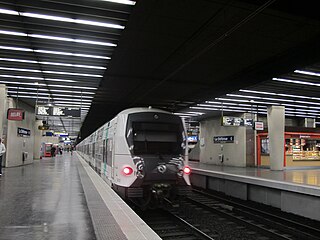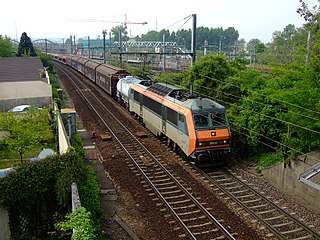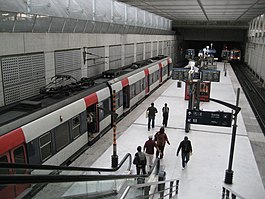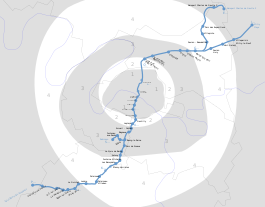
The Réseau Express Régional, commonly abbreviated RER, is a hybrid commuter rail and rapid transit system, similar to the S-Bahns of German-speaking countries and the S Lines of Milan, serving Paris and its suburbs. It acts as a combined city-center underground rail system and suburbs-to-city-center commuter rail. In the city center, it acts as a faster counterpart of the Paris Métro, having fewer stops.

The Ligne de Sceaux was a railway line in France running from Paris, which initially linked the Place Denfert-Rochereau (then called the Place d'Enfer, in Paris, to the town of Sceaux.

The Gare du Nord, officially Paris Nord, is one of the seven large mainline railway station termini in Paris, France. The station is served by trains that run between the capital and northern France via the Paris–Lille railway, as well as to international destinations in Belgium, Germany, the Netherlands and the United Kingdom. Located in the northern part of Paris near the Gare de l'Est in the 10th arrondissement, the Gare du Nord offers connections with several urban transport lines, including Paris Métro, RER and buses. It is the busiest railway station in Europe by total passenger numbers, and the busiest outside Japan. In 2015, the Gare du Nord saw more than 700,000 passengers per day.

RER A is one of the five lines in the Réseau Express Régional, a hybrid commuter rail and rapid transit system serving the city and suburbs of Paris, France. The 108.5-kilometre (67.4 mi) line crosses the region from east to west, with all trains serving a group of stations in central Paris, before branching out towards the ends of the line.

RER C is one of the five lines in the Réseau Express Régional, a hybrid commuter rail and rapid transit system serving Paris and its suburbs. The 186-kilometre (116 mi) line crosses the region from north to south. Briefly, between September 1979 and May 1980, the line was known as the Transversal Rive Gauche. The line is operated by SNCF.

RER D is one of the five lines in the Réseau Express Régional, a hybrid commuter rail and rapid transit system serving Paris and its suburbs. The 190-kilometre (120 mi) line crosses the region from north to south, with all trains serving a group of stations in central Paris, before branching out towards the ends of the line.

RER E is one of the five lines in the Réseau Express Régional, a hybrid commuter rail and rapid transit system serving Paris and its suburbs. The 60-kilometre (37 mi) line travels between western and eastern suburbs, with all trains serving the stations in central Paris, before branching out towards the ends of the line.

Line 4 is one of the sixteen lines of the Paris Métro rapid transit system and one of its three fully automated lines. Situated mostly within the boundaries of the City of Paris, it connects Porte de Clignancourt in the north and Bagneux-Lucie Aubrac in the south, travelling across the heart of the city. Until its southern terminus was changed from Porte d'Orléans to Mairie de Montrouge in 2013, the line was sometimes referred to as the Clignancourt – Orléans Line. At 13.9 km (8.6 mi) in length, it connects with all Paris Métro lines apart from the very short 3bis and 7bis branch lines, as well as with all 5 RER express lines. It also serves three of the Paris Railway stations, Gare du Nord, Gare de l'Est, and Gare Montparnasse. It is the second-busiest Métro line after Line 1, carrying over 154 million passengers in 2004.

Luxembourg is a French railway station on the RER B line in Paris. It is located under Boulevard Saint-Michel on the border between the 5th and 6th arrondissements, just east of the Jardin du Luxembourg. In 2015, it was used by 5,670,876 passengers.
Transilien Paris-Nord is one of the sectors in the Paris Transilien suburban rail network. The trains on this sector depart from Gare du Nord in central Paris, and serve the north-west and north-east of Île-de-France region with Transilien lines H and K. Transilien services from Gare du Nord are part of the SNCF Gare du Nord rail network.

Denfert-Rochereau station is a railway station in Paris. It was one of the first stations of the French railway network, and is still in use as a station of Paris' RER line B.

Massy TGV station is a TGV railway station in Massy, France. The station was built along the LGV Atlantique and serves as a transfer point to the regional rail system that stops at the nearby Massy-Palaiseau station.

Massy–Palaiseau station is a train station in the city of Massy. It is a junction of the RER B, RER C, Transilien Line V and tramway Line 12. In the future, Paris Métro Line 18 of Grand Paris Express will stop here. It is a station in this southern outer suburb of Paris, with a connection to the Massy TGV station.

The Grande Ceinture line is a railway line around Paris, located 15 kilometres (9.3 mi) from the Boulevard Périphérique. The decision to build it was taken at the end of the 19th century, to connect the radial lines linking the capital to the provinces and provide relief to the busy Petite Ceinture Line.

Bourg-la-Reine station is a railway station on the Sceaux line, located in the town of Bourg-la-Reine, Hauts-de-Seine, France.

The Communauté d'agglomérationParis-Saclay(or CPS) is an administrative entity in the Essonne département, near Paris. The administrative center is Orsay. It was formed on 1 January 2016 by the merger of the former Communauté d'agglomération du Plateau de Saclay (CAPS) and the Communauté d'agglomération Europ'Essonne(E²). Its area is 185.9 km2. Its population was 314,169 in 2018.
Jean-Claude-Républicain Arnoux was a French civil engineer known for his invention of the Arnoux system for articulating trains on tight curves. As an entrepreneur he founded and directed the Compagnie de Paris à Orsay, which constructed and operated the line from Paris to Orsay and is now part of the Ligne de Sceaux. It opened on 6 June 1846.
Paris Métro Line 18 is one of four new lines of Grand Paris Express, a major expansion project of the Paris Métro. Currently under construction, it will link Orly Airport to Versailles via Massy-Palaiseau, the Saclay Plateau, and Saint-Quentin-en-Yvelines. The line will be 35 kilometers (22 mi) long and will be fully automated. Subsequently, it is planned to be extended by about 15 kilometers (9.3 mi) from Versailles to Nanterre via Rueil-Malmaison.

The MS 61 was an electric multiple unit trainset that was operated on line A and line B of the Réseau Express Régional (RER), a hybrid suburban commuter and rapid transit system serving Paris and its Île-de-France suburbs.

The Z 23000 was a type of passenger train used by the Compagnie du Chemin de Fer Métropolitain de Paris (CMP).























